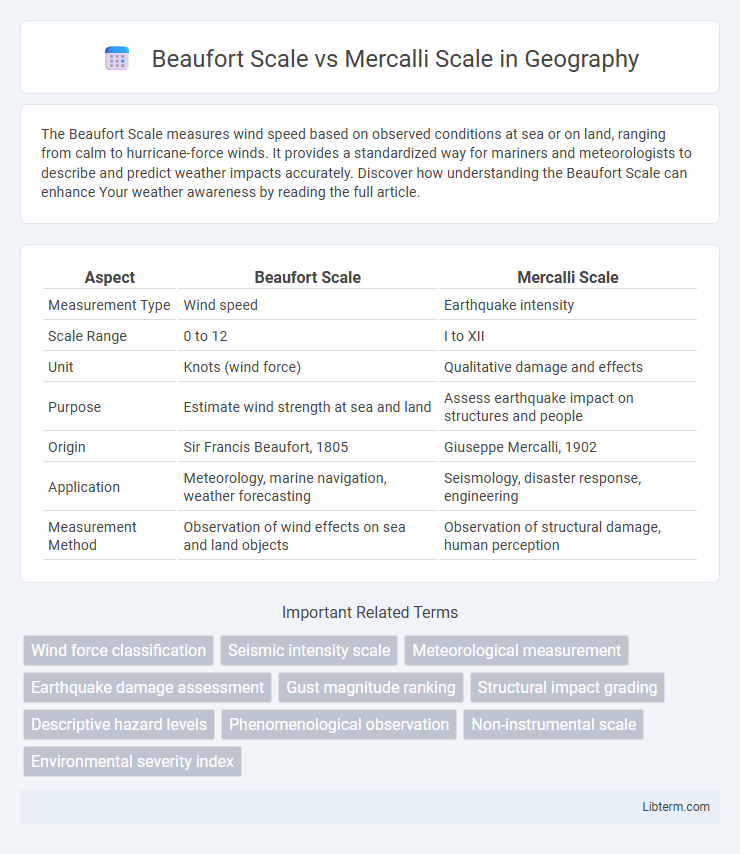The Beaufort Scale measures wind speed based on observed conditions at sea or on land, ranging from calm to hurricane-force winds. It provides a standardized way for mariners and meteorologists to describe and predict weather impacts accurately. Discover how understanding the Beaufort Scale can enhance Your weather awareness by reading the full article.
Table of Comparison
| Aspect | Beaufort Scale | Mercalli Scale |
|---|---|---|
| Measurement Type | Wind speed | Earthquake intensity |
| Scale Range | 0 to 12 | I to XII |
| Unit | Knots (wind force) | Qualitative damage and effects |
| Purpose | Estimate wind strength at sea and land | Assess earthquake impact on structures and people |
| Origin | Sir Francis Beaufort, 1805 | Giuseppe Mercalli, 1902 |
| Application | Meteorology, marine navigation, weather forecasting | Seismology, disaster response, engineering |
| Measurement Method | Observation of wind effects on sea and land objects | Observation of structural damage, human perception |
Introduction to Measurement Scales
The Beaufort Scale measures wind force based on observed sea conditions or land effects, ranging from 0 (calm) to 12 (hurricane), primarily used in meteorology and maritime navigation. The Mercalli Scale evaluates earthquake intensity by assessing observed damage and human perception, ranging from I (not felt) to XII (total destruction), essential for seismological impact studies. Both scales provide qualitative assessments through descriptive criteria, differing in application--wind force versus earthquake intensity.
What Is the Beaufort Scale?
The Beaufort Scale is a standardized system used to estimate wind speeds based on observed sea conditions and land effects, ranging from 0 (calm) to 12 (hurricane-force winds). Developed in the early 19th century by Sir Francis Beaufort, this scale helps meteorologists and mariners assess wind intensity without instruments. Unlike the Mercalli Scale, which measures earthquake intensity through observed damage, the Beaufort Scale specifically quantifies wind force and its impact on the environment.
Understanding the Mercalli Intensity Scale
The Mercalli Intensity Scale measures earthquake effects based on observed damage and human perception, categorizing intensity from I (not felt) to XII (total destruction), unlike the Beaufort Scale which quantifies wind force. This qualitative approach helps assess the impact of seismic events on structures, enabling emergency response prioritization and damage assessment. Understanding the Mercalli Scale is crucial for historical earthquake analysis and urban planning in seismically active regions.
Historical Background of Both Scales
The Beaufort Scale, created in 1805 by Sir Francis Beaufort, was initially designed to estimate wind force based on observed sea conditions before evolving to include land observations. The Mercalli Scale, developed by Italian volcanologist Giuseppe Mercalli in 1902, measures earthquake intensity through observed effects and damage on structures and people. Both scales serve distinct purposes in meteorology and seismology, with the Beaufort Scale focusing on wind force and the Mercalli Scale on seismic impact.
Purposes: Wind Force vs. Earthquake Intensity
The Beaufort Scale quantifies wind force by categorizing wind speeds from calm to hurricane-level conditions, essential for meteorological assessments and maritime navigation. The Mercalli Scale measures earthquake intensity based on observed effects and damage on structures and people, providing vital information for seismic risk analysis and emergency response. Both scales serve distinct purposes: Beaufort for atmospheric wind conditions and Mercalli for the localized impact severity of earthquakes.
Scale Descriptions and Ranges
The Beaufort Scale quantifies wind force based on observed sea conditions or land effects, ranging from 0 (calm) to 12 (hurricane force), with detailed descriptors such as "light breeze" at 4 and "strong gale" at 9. The Mercalli Scale measures earthquake intensity by its observable impacts on people, structures, and the Earth's surface, spanning from I (not felt) to XII (total destruction), with intermediate levels like VII (very strong) causing considerable damage. Both scales prioritize qualitative observations but differ in scope: Beaufort focuses on wind speed effects, while Mercalli emphasizes seismic damage severity.
Methods of Observation and Measurement
The Beaufort Scale measures wind speed based on observed sea conditions, using standardized criteria such as wave height and wind effects on sails, making it an empirical tool for sailors and meteorologists. In contrast, the Mercalli Scale assesses earthquake intensity through observed structural damage and human perception, relying on qualitative descriptions rather than instrumental readings. While the Beaufort Scale quantifies wind velocity indirectly, the Mercalli Scale provides a subjective evaluation of seismic impact without precise numerical magnitude.
Real-World Applications
The Beaufort Scale measures wind speed based on observed sea conditions or land effects, providing critical data for maritime navigation, weather forecasting, and disaster preparedness. The Mercalli Scale assesses earthquake intensity through observed damage and human perception, aiding structural engineering, emergency response, and urban planning in seismic zones. Both scales translate natural phenomena into actionable information, enhancing safety and resilience in their respective fields.
Limitations and Criticisms
The Beaufort Scale, designed primarily for estimating wind force, lacks precision in measuring wind speed and is unsuitable for sudden gusts or complex weather conditions. The Mercalli Scale, used for assessing earthquake intensity, relies on subjective observations of damage and human perception, resulting in inconsistent and location-dependent ratings. Both scales face criticism for their qualitative nature and limited applicability in scientific, quantitative analysis compared to modern instrumental measurements.
Key Differences and Comparative Analysis
The Beaufort Scale measures wind speed based on observed sea or land conditions, ranging from 0 (calm) to 12 (hurricane), while the Mercalli Intensity Scale assesses earthquake effects on people, structures, and the Earth's surface, rated from I (not felt) to XII (total destruction). The Beaufort Scale quantifies meteorological phenomena for weather forecasting and marine navigation, whereas the Mercalli Scale provides qualitative descriptions of seismic intensity for damage assessment and emergency response. Key differences include their application domains--meteorology versus seismology--and the nature of measurements: objective wind force versus subjective human and structural impact.
Beaufort Scale Infographic

 libterm.com
libterm.com